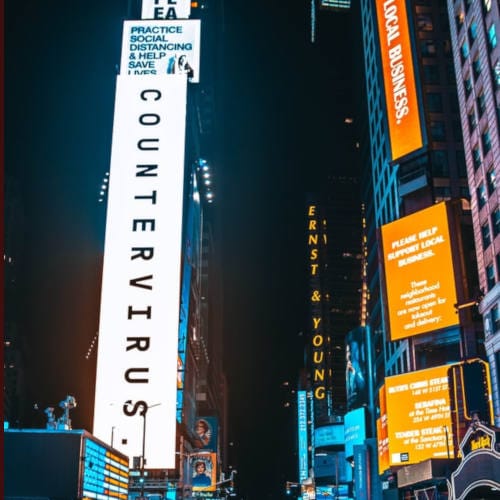As vast parts of the world went into Covid-19 lockdown over the past months critics of this approach have emerged from a broad spectrum: amongst others, libertarians who abhor the intruding state, business owners who see their profits at stake and activists who observe dramatic consequences for the poor. However, comparatively few voices have come forward to criticize the global spread of the lockdown approach from a grounded public health and social science perspective, and based on the history of pandemic preparedness.
Taking such a stance, Carlo Caduff, medical anthropologist and associate professor at King’s College London, has been vocal on Twitter and in his paper “What Went Wrong: Corona and the World after the Full Stop” (forthcoming in Medical Anthropology Quarterly). In “What Went Wrong” Caduff urgently calls to “to look beyond the virus if we really want to understand what is happening today” and to abandon a model-based policy that brackets out the social and economic consequences of the pandemic response. Caduff’s critical perspective on the present ties in with his earlier work on a decade of global pandemic preparedness which he published in his 2015 book The Pandemic Perhaps: Dramatic Events in a Public Culture of Danger. Over the past two weeks, I conversed with Carlo Caduff in written form on central themes in his critique of the current pandemic response, the contradictions of preparedness and the struggle to come.
TM: Governments around the world have introduced drastic lockdowns that are explained as measures to “save lives” and “flatten the curve” of new Covid-19 infections. In your recent paper “What went wrong” you provide a radical critique of such lockdowns and their overemphasis on epidemiological modelling. What are the central points in this critique of the “magic of numbers” and, to use your own words, “the assumption that biological life is an absolute value separate from politics”?
CC: Clearly, mathematical disease modelling has played a crucial role in this pandemic – it has been used to shift government policies and justify lockdowns. It has also side-lined a classic public health approach, namely to test, trace and isolate.
South Korea and Germany put all emphasis on testing early on and managed the pandemic quite well – other countries put testing at scale second and left local public health officials without any ground data. These local public health officials are now flying blind – they have no idea what’s going on in their communities because they don’t have enough testing capacity. This has hampered the response a lot.
So, in a sense, we have some numbers, the speculative/calculative numbers derived from modelling, but in many countries, we still don’t have systematic surveillance, using both RT-PCR as well as serological tests. Without this kind of surveillance, it becomes difficult to know what’s going on.
We should also keep in mind that disease modelers always said that lockdowns need to stay in place until a vaccine becomes available. So that basically means for 12-18 months or even more. It’s a puzzle to me how this unsustainable strategy became an international norm. We can see how difficult it is to get out of a lockdown once it has been imposed and we always knew that it wouldn’t solve the problem that this virus is posing. The virus is still spreading; it can’t be eradicated.
Last but not least, people died, both in countries where there was a lockdown as well as in countries where there was no lockdown. To say it prevented more deaths in countries where it was imposed early on is misleading because we really don’t know when the virus started to spread – it increasingly turns out that the virus was present for a much longer time than we thought. So, what does “early” mean? A lot of what people say these days is speculation.
TM: In your 2015 book The Pandemic Perhaps you discuss how past “pandemic prophecy,” fostered by experts on pandemic preparedness, invoked apocalyptic tropes, but was void of any sort of hope or vision for the post-apocalyptic world. Now that large parts of the world have come to a “full stop” such visions seem to mushroom in the form of authoritarian fantasies – destruction, a clean slate, control, surveillance, border closures and national sovereignty. How do you assess the link between the culture of danger that has resulted from pandemic preparedness and the ruthless, if not brutal, actions taken in the name of containment today?
CC: This is a key point. The pandemic has become an opportunity, an opening for many actors and institutions. All kinds of things are happening today. In India, the government started suspending key labour laws. In Hungary, the Prime Minister has now more power than ever. There are all kinds of political agendas that are put into practice. Some people even think today’s state of exception should be the “new normal.”
Pandemic times are auspicious times. Things that were not possible a year ago, are now suddenly possible, and there seems to be little resistance because everyone is confined at home and mentally exhausted by the isolation, the home schooling and childcare, and the fear and panic that has been spreading like a wildfire. Also, many are deeply worried about the future. Millions have lost their jobs. There’s a lot of depression and despair, especially in the Global South, where lockdowns have pushed societies to the edge of collapse. In Lebanon, 50% of the population is now living below the poverty line. 75% need food aid. Jobs disappeared. Salary cuts are the norm. Inflation has made basic goods extremely expensive, including rents. The consequences of the lockdown are catastrophic. As I have written in “What Went Wrong”, this pandemic response will haunt us for decades in ways that we can barely imagine at this point.
Today, many attribute incredible power and agency to the virus. However, a virus causes disease, not hunger and unemployment. It’s not the pandemic, but the response to it that threatens the livelihood of millions of people. We need to take responsibility for what we are doing to people in the name of survival.
TM: In “What went wrong” you sketch a diffusion of lockdown methods from China to Europe and the United States to countries of the Global South. You suggest that in many of these contexts the lockdown conceals the complete lack of preparedness for such a pandemic – despite years of apparent preparations on a global scale. What are, in your view, the larger political and economic processes that have led to this wide gap between expected and actual preparedness?
Pandemic times are auspicious times. Things that were not possible a year ago, are now suddenly possible.
CC: This is a complex question that will require detailed empirical investigation. Part of it may have to do with institutional forgetting. However, it is stunning how governments across the world came forward with an improvised and untested pandemic response – when they had been preparing for over 15 years for such an event and had drawn up extremely detailed plans and guidelines. Unfortunately, very few of these plans and guidelines were put into practice when the virus emerged. For some reason, a crude version of China’s locked-city approach became the norm. When the locked-city approach was taken up by Italy and other European governments it became a locked-country approach. This was even more extreme than what China had done to manage the crisis. No one knew – nor seemed to be concerned with – the costs and consequences of such an extreme intervention.
National lockdowns were not part of pandemic preparedness plans. They figured only in mathematical disease models. Disease modelers were playing with the idea as a theoretical option – but no one else took it seriously because it seemed extreme, unprecedented and unjustifiable.
To some extent, fragility has always been both a condition as well as a result of preparedness – this may sound contradictory, but preparedness in the United States has always been a contradictory project, as I have argued in my book. Governments closed down hospitals to “rationalize” medical care and make it more “efficient.” The remaining hospitals were asked to prepare for a pandemic. This contradiction has been at the heart of preparedness under neoliberalism. Preparedness always assumed that the public health infrastructure would not be able to deal with a pandemic – hence the emphasis on coming up with ideas to minimize the disaster, not prevent it.
In April, in the midst of the pandemic, American hospitals cut salaries, laid off hundreds of staff and send others on unpaid leave because the pandemic response cut off a main source of income, with patients avoiding hospitals due to fear of infection. In the midst of the pandemic, the system got weakened further. While the virus was spreading, hospitals and nursing homes in the United States laid off over 260,000 staff in one single month… This is how preparedness works in the United States.
The Johns Hopkins Global Health Security Index assessed the preparedness of countries last year. The international panel of experts gave the first rank for “preparedness” to the US, the second rank went to the UK. Germany got rank 14, Greece 37 and Vietnam 50. It looks like the ranking needs revision. A few questions might also be raised about the politics of preparedness expertise.
TM: In your analysis, South Korea features as a positive example that followed a classic infectious disease intervention approach and avoided a lockdown through early mass testing, rigorous contact tracing and the isolation of cases. Possibly other examples such as Hong Kong and Taiwan could be named here as well. Why do you think these examples did not more prominently influence responses in other parts of the globe?
CC: I wish I had an answer to this question. My sense is that Italy played a crucial role, because it was the first country in this pandemic with a national lockdown. It appropriated the Chinese locked-city strategy and turned it into something else: a locked-country strategy. As I already mentioned, this strategy figured only in mathematical disease models, but not in official pandemic preparedness plans.
The Imperial College disease model report released a few days after Italy’s surprising national lockdown announcement played an important role. The report garnered a lot of attention, created a sense of urgency and amplified the political pressure because the numbers were alarming. The model predicted 510,000 deaths in the United Kingdom and 2,2 million deaths in the United States. It suggested “suppression” of the pandemic as the only possible strategy. This moment of shock and surprise triggered a chain reaction in the pandemic response. The horizon shifted, the inconceivable became possible, and life suddenly felt surreal.
TM: Your conclusions, both in your book and in “What went wrong”, are not only sobering assessments of pandemic preparedness, but of the state of our present more generally. You mention that we live in a world in which a lack of imagination forces us to adopt a language that “is contaminated with words that are stiff, stale and corrupt like putrid air.” While the pandemic is not the source of global inequality and suffering it will no doubt bring these to new levels. What, in your opinion, needs to be urgently done to move beyond what you call a “strange space of thinking, acting and feeling that has normalized extremes”?
CC: As many have said, the pandemic and the response to it, are an opportunity to rethink and rebuild the world, in ways that will hopefully be less toxic. The struggle will be between those who want to use the current situation and impose a “new normal” and those who are invested in thinking the world otherwise.






I agree with the article, but I think that more people should have the courage to defend the few world leaders who opposed this “herd movement”, from the rest of the world! as a Swedish leader, the Brazilian and the United States! it’s how I think
Carduff’s work is valuable. I’d like to point out, though, that we are indeed between a rock and a hard place in more ways than one. The South Korean model, for example, as successful as it may have been in dealing with the pandemic per se, made extensive use of digital surveillance. From this angle, it’s a lose-lose situation, at least for the general population, for the down-below: either we suffer the impact of lockdowns etc. and grow accustomed to the exception-as-the-rule model, or we consent to an unprecedented concession of data to be used from governments and institutions as they see fit.
How true! Even as a symptomatic person being tested and not vaccined, your name is registered in the government data I’m living.
And it’s a democracy, apparently the oldest in Europe.
We are already there. Only the mass is convinced they still have a choice.
Right now the only issue I see in the politics is, “How am I going to tell my children?” and preventing riots and further demos, declining the social freedom.